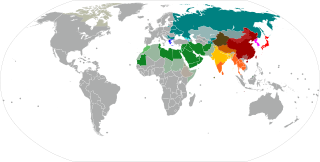Related Research Articles

Devanāgarī or Devanagari, also called Nāgari, is a left-to-right abugida, based on the ancient Brāhmi script, used in the northern Indian subcontinent. It is one of the official scripts of the Republic of India and Nepal. It was developed and in regular use by the 7th century CE and achieved its modern form by 1000 CE. The Devanāgari script, composed of 48 primary characters, including 14 vowels and 34 consonants, is the fourth most widely adopted writing system in the world, being used for over 120 languages.

The Sinhala script, also known as Sinhalese script, is a writing system used by the Sinhalese people and most Sri Lankans in Sri Lanka and elsewhere to write the Sinhala language as well as the liturgical languages Pali and Sanskrit. The Sinhalese Akṣara Mālāva, one of the Brahmic scripts, is a descendant of the Ancient Indian Brahmi script. It is also related to the Grantha script.

The Kannada script is an abugida of the Brahmic family, used to write Kannada, one of the Dravidian languages of South India especially in the state of Karnataka. It is one of the official scripts of the Indian Republic. Kannada script is also widely used for writing Sanskrit texts in Karnataka. Several minor languages, such as Tulu, Konkani, Kodava, Sanketi and Beary, also use alphabets based on the Kannada script. The Kannada and Telugu scripts share very high mutual intellegibility with each other, and are often considered to be regional variants of single script. Other scripts similar to Kannada script are Sinhala script, and Old Peguan script (used in Burma).

The Brahmic scripts, also known as Indic scripts, are a family of abugida writing systems. They are used throughout the Indian subcontinent, Southeast Asia and parts of East Asia. They are descended from the Brahmi script of ancient India and are used by various languages in several language families in South, East and Southeast Asia: Indo-Aryan, Dravidian, Tibeto-Burman, Mongolic, Austroasiatic, Austronesian, and Tai. They were also the source of the dictionary order (gojūon) of Japanese kana.

Malayalam script is a Brahmic script used commonly to write Malayalam, which is the principal language of Kerala, India, spoken by 45 million people in the world. It is a Dravidian language spoken in the Indian state of Kerala and the union territories of Lakshadweep and Puducherry by the Malayali people. It is one of the official scripts of the Indian Republic. Malayalam script is also widely used for writing Sanskrit texts in Kerala.
Devanagari is an Indic script used for many Indo-Aryan languages of North India and Nepal, including Hindi, Marathi and Nepali, which was the script used to write Classical Sanskrit. There are several somewhat similar methods of transliteration from Devanagari to the Roman script, including the influential and lossless IAST notation. Romanized Devanagari is also called Romanagari.
When used as a diacritic mark, the term dot refers to the glyphs "combining dot above", and "combining dot below" which may be combined with some letters of the extended Latin alphabets in use in a variety of languages. Similar marks are used with other scripts.
A ring diacritic may appear above or below letters. It may be combined with some letters of the extended Latin alphabets in various contexts.
The International Alphabet of Sanskrit Transliteration (IAST) is a transliteration scheme that allows the lossless romanisation of Indic scripts as employed by Sanskrit and related Indic languages. It is based on a scheme that emerged during the 19th century from suggestions by Charles Trevelyan, William Jones, Monier Monier-Williams and other scholars, and formalised by the Transliteration Committee of the Geneva Oriental Congress, in September 1894. IAST makes it possible for the reader to read the Indic text unambiguously, exactly as if it were in the original Indic script. It is this faithfulness to the original scripts that accounts for its continuing popularity amongst scholars.

Ś is a letter of the Latin alphabet, formed from S with the addition of an acute accent. It is used in Polish and Montenegrin alphabets, and in certain other languages or romanizations.
Ɽ, ɽ is a letter of the Latin alphabet, derived from R with the addition of a tail. Its capital form may be based on either the uppercase or lowercase R.
Ṣ is a letter of the Latin alphabet, formed from an S with the addition of a dot below the letter. Its uses include:

Ḍ is a letter of the Latin alphabet, formed from D with the addition of a dot diacritic.

Ḷ is a letter of the Latin alphabet, derived from L with a diacritical dot below. It is or was used in some languages to represent various sounds.
Unicode supports several phonetic scripts and notations through its existing scripts and the addition of extra blocks with phonetic characters. These phonetic characters are derived from an existing script, usually Latin, Greek or Cyrillic. Apart from the International Phonetic Alphabet (IPA), extensions to the IPA and obsolete and nonstandard IPA symbols, these blocks also contain characters from the Uralic Phonetic Alphabet and the Americanist Phonetic Alphabet.
Ṭ is a letter of the Latin alphabet, formed from T with the addition of a dot below the letter.
Ẓ is a letter of the Latin alphabet, formed from Z with the addition of a dot below the letter. It is used in the transcription of Afroasiatic languages, specifically:
Mal Paharia is a language spoken by 51,000 of 110,000 ethnic Mal Paharia in the states of Jharkhand and West Bengal in India, and regions of Bangladesh. The language is also known as Mal Pahoria, Malto, Malti, Paharia, Parsi, and Mal Pahariya. It has been variously regarded as a Bengali–Assamese language, a dialect of Malto, and a mixed Dravidian–Indo-Aryan language. There is a generally positive attitude among speakers of the language towards it, but it is considered vulnerable as some speakers have shifted to Bengali. Mal Paharia uses the Devanagari script and rules for its writing, reading, and speech.
ISO 11940 is an ISO standard for the transliteration of Thai characters, published in 1998 and updated in September 2003 and confirmed in 2008. An extension to this standard named ISO 11940-2 defines a simplified transcription based on it.

The Bengali script or Bangla alphabet is the alphabet used to write the Bengali language based on the Bengali-Assamese script, and has historically been used to write Sanskrit within Bengal. It is one of the most widely adopted writing systems in the world . It is one of the official scripts of the Indian Republic. It is used as the official script of the Bengali language in Bangladesh, West Bengal, Tripura and Barak valley of Assam as well as the Meitei language in Manipur, two of the official languages of India.
References
- ↑ "Unicode Character "Ṛ" (U+1E5A)". Compart. Oak Brook, IL: Compart AG. 2021. Retrieved 2024-02-17.